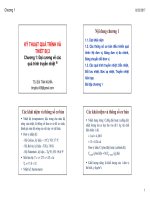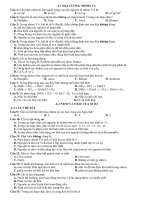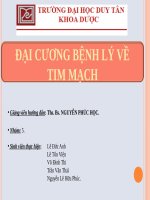Đại cương về thiết kế nghiên cứu định tính. Gs,ts,bs Lê Hoàng Ninh
Bạn đang xem bản rút gọn của tài liệu. Xem và tải ngay bản đầy đủ của tài liệu tại đây (12.86 MB, 60 trang )
Đại cương về thiết kế
nghiên
cứu
định
tính
Gs,ts,bs lê hồng ninh
Nghiên cứu định tính là gì?
Tập trung trên chất chứ khơng phải lượng
Phát triển / hình thành giả thuyết chứ không
kiểm định giả thuyết
Điều tra : TẠI SAO và THẾ NÀO ?
Thu thập dữ liệu gồm : phỏng vấn,nhóm chủ
đích, tư liệu, quan sát...
Dữ liệu: bài văn, hình nghệ thuật, ảnh...
2
Tại sao dùng
cách tiếp cận định tính?
Câu hỏi nghiên cứu liên can tới sự tìm hiểu, mơ
tả một hiện tượng / biến cố đặc biệt nào đó mà
sự am hiểu cịn rất hạn chế
Để có được những đặc điểm khía cạnh không
thể định lượng được vế cuộc sống của con
người.
Hiện tượng quan tâm có liên can tới dự hiểu biết
về sự trải nghiệm, ý nghĩa sâu xa, tình cảnh, sự
cảm kích và những khía cạnh xảy ra hằng ngày
của các thành viên hay của nhóm
3
Đề cương nghiên cứu định tính
Câu hỏi và mục tiêu nghiên cứu
Hồi cứu y văn và các ghi nhận có tính lý thuyết
Người tham gia
- Bạn quyết định bạn muốn thế nào?
- Bạn cần bao nhiêu?
- Bạn nhận họ vào thế nào?
Thu thập dữ liệu
- bạn sẽ thu thập dữ liệu nào?
- thu thập thế nào?
Data analysis
- bạn làm gì với dữ liệu đó ?
Chuyển dịch kiến thức
- làm cách nào để mọi người biết, hiểu được cái mà bạn tìm
được qua nghiên cứu
4
Câu hỏi và mục tiêu nghiên cứu
• Câu hỏi nghiên cứu phải là một câu hỏi:
thường là Tại Sao hay Thế Nào ?
• Mục tiêu nên nêu rõ, chuyên biệt về cái
mà bạn đang muốn làm
• Khơng có trước giả thuyết nghiên cứu
trong nghiên cứu định tính
5
Thí dụ câu hỏi nghiên
cứu định tính
Thí dụ
câu hỏi nghiên cứu định tính
Văn hố nghề nghiệp thể hiện như thấ nào ở
các học viên chuyên khoa 2 của 3 tỉnh tay ninh,
bình dương, b.r vũng tàu?
Bệnh nhân thể hiện sự cảm xúc thế nào khi chờ
đợi 3 gio82 để được bác sĩ thăm khám bệnh
trong 3 phút.
Học viện chun khoa cấp 2 có suy nghỉ gì khi
đề cương bị bác và làm lại đề cương khác.?
Hồi cứu y văn (Literature Review)
What has already been done?
What do we already know?
Where are the gaps in the literature?
Why is your study necessary?
Why is a qualitative approach the best
option?
“sensitizing concepts”
8
Phương pháp định tính
Examples include:
Ethnography
Phenomenology
Grounded Theory
Case Study
9
Dân tộc học (Ethnography)
Approach rooted in Cultural Anthropology &
Sociology
Focuses on the description and interpretation of
cultural patterns of groups
Understanding cultural meanings people use to
organize and interpret their experiences
Researcher studies the meaning, behaviour ,
language, and interactions of a culture-sharing
group
Data collection usually involves multiple sources
and often includes observation; can take many
months or years
10
Phenomenology
Based in philosophy, psychology and sociology
Focus is to uncover the meaning of how humans
experience phenomena through description of
those experiences as they are lived by
individuals
E.g., what is the meaning of “healing” to women
with cancer?
Focuses on experiences from the perspective of
the individual (not a group)
Data collection usually by individual interviews –
sometimes multiple interviews of same person
11
Phenomenology Example
Ribau C and JP Marc-Vergnes. “ Towards a
phenomenology of persistant pain” Pesse
Medicale 2004; 33(7): 449-52
12
Grounded Theory
Primarily used to develop a theory or conceptual
model – based in sociology
Generally begins with a broad query and collects
all relevant information
Each piece of info is reviewed, compared and
contrasted with earlier collected info (constant
comparison)
Range of data collection techniques can be
used; usually includes interviews
13
Grounded Theory Examples
Chaar B and Kwong K. “Direct-to-consumer
advertising: Australian pharmacists’ experiences
with non-prescription medicines.” International
Journal of Pharmacy Practice. 2010;18(1):43-50.
Pottie K, et al. “Pharmacist’s identity
development within multidisciplinary primary
health care teams in Ontario: qualitative results
from the IMPACT project” Research in Social
Administrative Pharmacy 2009; 5(4):319-26.
Benson A et al. “Understanding pharmacists’
values: a qualitative study of ideals and
dilemmas in UK pharmacy practice” Social
Science & Medicine 2009; 68(12):2223-30.
14
Case Study
In-depth analysis of single cases or comparison
across multiple cases
Comes from Political Science, Sociology
Data collection normally includes a variety of
sources including documents, interviews and
observation
Data from different sources are triangulated
When multiple cases are available, case-bycase analysis is completed first, followed by
cross-case comparisons
15
Case Study Example
Knapp DA et al. “Growth of a pharmacy school
through planning, cooperation, and
establishment of a satellite campus” American
Journal of Pharmaceutical Education 2009;
73(6):102
Nanji KC et al. “Overcoming barriers to the
implementation of a pharmacy bar code
scanning system for medication dispensing: a
case study” Journal of the American Medical
Informatics Association 2009; 16(5):645-50
16
Objectives/Questions strongly
influence methodology choice
If one is interested in focusing on social groups,
then one may reject phenomenology
OR
if one is interested in individuals’ experiences,
then ethnographic or case study approaches
might be rejected
17
Data Collection
Match to your methodological approach
What kind of data do you need:
Individual vs group
Interviews vs focus groups
Documents
Observation
Are multiple methods appropriate (triangulation)?
18
Forms of Data
Generally anything that can be reduced to text:
- interview and focus group transcripts
- documents
- field notes
- observational notes
- reflective journaling
19
Interviewing
Common to almost every form of qualitative
research methodology
What varies is:
- types of questions
- length
- amount of structure vs. flexibility
- interviewers’ role
- analysis
Essentially the ONLY data collection technique
for phenomenology
20
Interviews in….
Ethnography: hold equal weight with
observation; multiple interviews over extended
period of time
Phenomenology: very in-depth, unstructured,
small number (<10)
Grounded Theory: continue until reaching
saturation of key emerging themes in the
developing theory
Case Studies: only one of multiple sources; often
use key informants
21
Individual Interviews
General Rules of Thumb
“A good interview is like a good conversation”
Good interviewer may not say much, but
works hard at listening
Unstructured or semi-structured
Vary in length: average in literature 60-90
minutes
22
Wording Questions
Interview GUIDE with general topics and themes
to be discussed
Exact wording and order should be altered to fit
each individual – follow the participant’s lead
“Not knowing” questioning strategy born out of
genuine curiosity
Questions should be open-ended
Avoid questions that may be perceived as “tests”
of knowledge: “Tell me about that” instead of
“what do you know about that?”
23
Sample
Interview
Guide
24
Audio Recording
Allows you to interact with the participant instead
of writing notes constantly
Provides higher quality data (better record of
what was actually said)
Place recording device closer to the participant
Check recording immediately after interview
Supplement with field notes
Can be costly (and time consuming) to
transcribe
25









